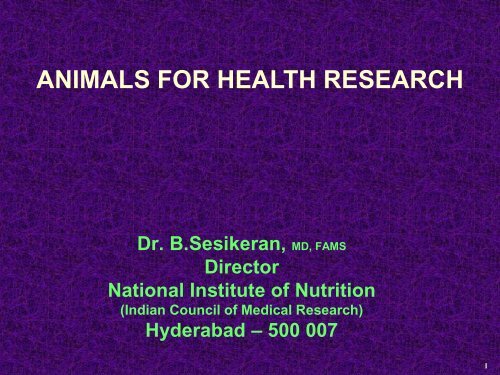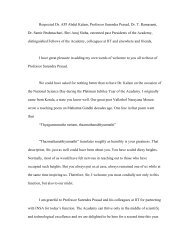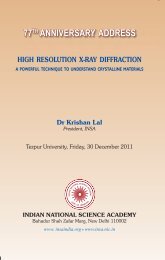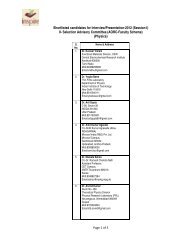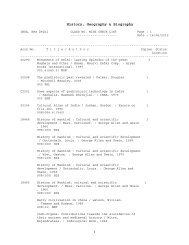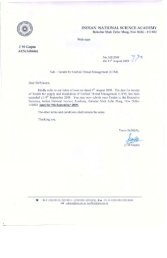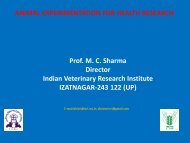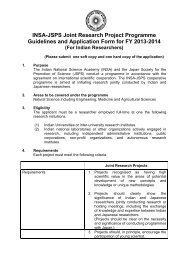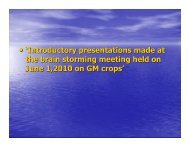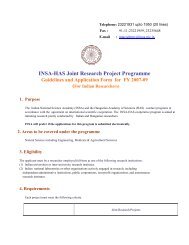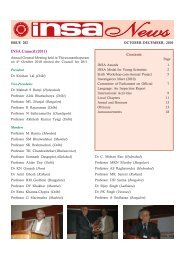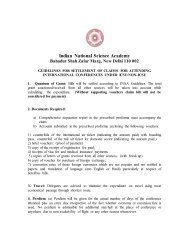Dr. B.Sesikeran
Dr. B.Sesikeran
Dr. B.Sesikeran
You also want an ePaper? Increase the reach of your titles
YUMPU automatically turns print PDFs into web optimized ePapers that Google loves.
ANIMALS FOR HEALTH RESEARCH<br />
<strong>Dr</strong>. B.<strong>Sesikeran</strong>, MD, FAMS<br />
Director<br />
National Institute of Nutrition<br />
(Indian Council of Medical Research)<br />
Hyderabad – 500 007<br />
1
MAN DEPENDED ON ANIMALS<br />
FOR SURVIVAL<br />
• Food: Cattle, Sheep, Pig, Poultry<br />
• COMPETITION AND COMPANION SHIP<br />
• ACQUISITION OF KNOWLEDGE<br />
(Galen 129-200 AD - Wild deer, Artery<br />
contained blood not air)
RESEARCH IN ANIMALS OVER 100<br />
‣ Understanding of the basic functioning of mammalian<br />
physiology<br />
‣ Causes and process of disease<br />
‣ Mechanism of infectious diseases & immunity & Noncommunicable<br />
diseases<br />
‣ Methods to prevent them<br />
YEARS LEAD TO<br />
‣ Discovery of nutrients, anti-nutrients, non-nutrients,<br />
toxicants, antidotes, drugs etc.<br />
‣ Finally to help human & animals lead a relatively better<br />
quality of life
DISCOVERIES<br />
•1600’s - Discovery of blood circulation<br />
• Discovery of the function of the lungs<br />
•1700’s - Measurement of blood pressure<br />
•1800’s - Vaccination to stimulate immunity<br />
• Understanding of infectious diseases<br />
•1900’s - Discovery of antibodies<br />
• Understanding of hormone systems<br />
•1920’s - Discovery of vitamins<br />
•1930’s<br />
impulses<br />
- Discovery of the mechanism of nerve<br />
• Discovery of tumour viruses
DISCOVERIES (Contd..)<br />
1940’s - Understanding of embryonic development<br />
1950’s - Understanding the control of muscle activity<br />
1960’s - Discovery of monoclonal antibodies<br />
Understanding the biochemical functions of the liver<br />
1970’s - Understanding of transplantation antigens<br />
Understanding the way the brain functions<br />
Discovery of prostaglandins<br />
1980’s - Development of transgenic animals<br />
understanding the basis of memory<br />
1990’s - Understanding auto immune disorders<br />
In vitro fertilization, cloning, gene manipulation<br />
2000’s - Regeneration, stem cells, epigenetics
TRANSLATION OF DISCOVERIES<br />
1920’s - Insulin for diabetes<br />
1930’s - Modern anaesthetics for surgery, Diphtheria vaccine<br />
1940’s - Broad-specturm antibiotics for infections<br />
Whooping cough vaccine<br />
Heart-lung machine for open-heart surgery<br />
1950’s - Kidney transplants<br />
Cardiac pacemakers and replacement heart valves<br />
Polio vaccine<br />
<strong>Dr</strong>ugs for high blood pressure<br />
Hip replacement surgery<br />
1960’s - Corneal transplants<br />
Rubella vaccine<br />
Coronary bypass operations<br />
Heart transplants<br />
<strong>Dr</strong>ugs to treat mental illness
TRANSLATION OF DISCOVERIES (Contd..)<br />
1970’s - <strong>Dr</strong>ugs to treat ulcers<br />
Improved sutures and other surgical techniques<br />
<strong>Dr</strong>ugs to treat asthma<br />
<strong>Dr</strong>ugs to treat leukaemia<br />
1980’s - Immunosuppressant drugs for organ transplants<br />
CAT scanning for improved diagnosis<br />
Life-support systems for premature babies<br />
<strong>Dr</strong>ugs to treat viral disease<br />
1990’s - Laproscopic surgical techniques<br />
Breast Cancer Links<br />
Gene therapy for cystic fibrosis<br />
2000’s - Stem cell therapy
LABORATORY ANIMAL<br />
“Man made biological tool, nurtured in a<br />
controlled environment. Maintained on a<br />
standard diet free from known pathogens<br />
and of a defined genetic background”
WILD<br />
LABORATORY<br />
MOUSE<br />
RAT<br />
HAMSTER
WILD<br />
LABORATORY<br />
GUINEA PIGS<br />
RABBIT
World of Laboratory Animals
‣ Do we know everything about disease processes<br />
‣ Have we conquered all diseases<br />
‣ Do we have valid alternatives to lab animals<br />
• In silico - Simulations – Virtual<br />
– not real<br />
• In vitro - Single cell responses do not<br />
capture other variables<br />
• Lab animal studies have transformed therapy<br />
“Incurable” diseases to completely curable.<br />
• Facilitated early diagnosis<br />
• Led to minimally invasive procedures
Why not human models<br />
‣ Many confounding factors<br />
‣ Genetic variability<br />
‣ Phenotypical variability<br />
‣ Environmental variability<br />
‣ Cloned humans could be future<br />
“Lab animals”<br />
Until then………………………
FUTURE AGENDA<br />
‣ Developmental origins of adult health &<br />
disease - for better management<br />
‣ Cancer biology & therapy<br />
‣ Early biomarkers of pathological<br />
processes<br />
‣ Validation of alternatives to animal models<br />
14


